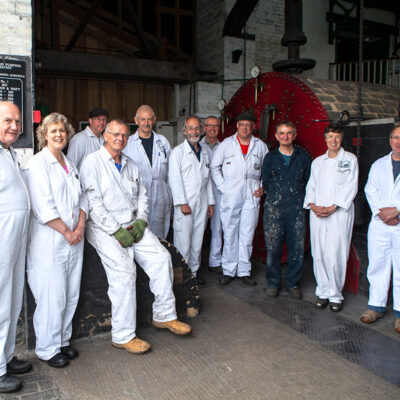The Water Pumps
Crofton’s No.1 engine uses a lift pump, whereas the No.2 engine has a force pump.
Force pumps were developed and adopted by Cornish engineers in preference to lift pumps because the pump plunger and its operating rod stand to one side of the rising main, thus making for easier maintenance where rising mains of substantial lengths are concerned – typical Cornish tin mines were around 400 m deep (nearly a quarter of a mile). Thus, it is no surprise that Harvey’s installed a force pump when they built the No.2 engine.
The problems of maintaining lift pumps are illustrated by the experiences described later on this page.

The No.2 engine was originally double acting, and therefore able to push the water pump plunger down as well as lift it up. When, in 1905, this engine was converted to conventional Cornish design, the plunger needed to be weighted in order to be able to force the water up the rising main by means of its own weight. It was therefore filled with scrap iron, a discovery made by volunteers during an examination made in around 2000. In 2012, the scrap was removed (a manual operation taking three days) during a major inspection of the plunger and replaced with clean, un-corroded material. The plunger weighs, in total, around 6.5 tonnes.

Section – The Purnis Foot Valve
The valves in the No.1 pump are not original, having been replaced by the GWR in the early 1900s with bronze units to the Purnis design consisting of a conical stack of interlocking bronze rings. The valves were made at GWR’s Swindon works and the original drawings still exist. Here is a picture of the foot valve in its chamber at the bottom of the rising main.
The valves in the No.2 pump are Harvey Double Beat and have seating rings made of wooden segments. The valves are original although the wooden rings are periodically renewed due to wear. An example of one of these Double Beat Valves is on display at rear of the Boiler House and is shown left.
Both pumps are 76 cm (30 inch) bore by 2.4 m (8 ft) stroke.
Early Problems with the Pump Valve
Non-return water valve – The first attempt at running the No.1 Engine after restoration had to be abandoned because the water pump would not ‘pick up’ due, it was suspected, to sticking valves. One of the younger members of the volunteer team (i.e. slimmer/more foolhardy) was persuaded to allow himself to be lowered down the rising main on a rope in order to try to free the valves.
Considering that the rising main is some 12 m (40 ft) high, has a bore of only 80 cm (30 inches) and contains a central pump rod in it of 15 cm (6 inches) diameter, this must have been a somewhat daunting task! In the event, the volunteer was not able to clear the blockage, and eventually the pump rod with its plunger was removed. The latter was another ‘interesting’ task. One has to understand that the pump rod is in one piece, just over 12 m (40 ft) long and the whole assembly weighs about half a ton! Fortunately, there was a hatchway in the roof of the building to permit the rod to be lifted through. It took a day and a half to get the rod out, half a day to clean the solidified oil from the valves and another day and a half to put it all back again. It must have been a surprising sight for the local residents to see the station with a length of wrought iron pump rod sticking out of the roof!














